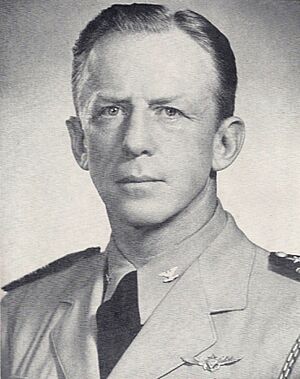John G. Crommelin facts for kids
Quick facts for kids
John Geraerdt Crommelin Jr.
|
|
|---|---|
 |
|
| Nickname(s) | "Bomb-run John" |
| Born | 2 October 1902 Montgomery, Alabama |
| Died | 2 November 1996 (aged 94) Montgomery, Alabama |
| Allegiance | United States of America |
| Service/ |
United States Navy |
| Rank | Rear Admiral |
| Unit | Naval aviation, USS Enterprise, Navy headquarters |
| Battles/wars | World War II |
| Other work | Gubernatorial, Senate, vice presidential and presidential candidate |
Rear Admiral John Geraerdt Crommelin Jr. (October 2, 1902 – November 2, 1996) was an important officer in the United States Navy. After his military career, he often ran for political office. He held strong, controversial beliefs about race.
Contents
John G. Crommelin Jr. was born in Montgomery, Alabama. He was the oldest of five brothers. He graduated from the United States Naval Academy in Annapolis, Maryland in 1923. He spent his childhood in Montgomery and in Elmore County, Alabama.
Serving in World War II
Crommelin fought in the Pacific during World War II. All of his brothers also graduated from the US Naval Academy. Sadly, two of them died while fighting in World War II.
Crommelin became known as a brave and skilled naval pilot. He earned the nickname "Bomb-run John." He served as an executive officer (a senior leader) and air officer on the aircraft carrier USS Enterprise. He was also the chief of staff (a top assistant) on the carrier USS Liscome Bay (Liscome Bay) when it was sunk during the Makin Island campaign.
In 1946, Captain Crommelin was put in charge of the light aircraft carrier USS Saipan.
Speaking Out in Washington
In 1949, he moved to Navy headquarters in The Pentagon in Washington, D.C. At this time, the military was cutting its budget. Captain Crommelin became a strong critic of military policies. He warned that concentrating military power in too few hands was dangerous.
Even though he was still serving, he publicly complained. He felt the Defense Department was weakening the Navy's air power. He also believed they were unfairly favoring the Air Force.
During this time, some Navy leaders disagreed with the Defense Department's plans. Crommelin shared some private letters from these leaders. His strong opposition to reducing the Navy's size put him in a difficult position. The Navy's top officer, Forrest P. Sherman, publicly criticized Crommelin. He was then moved to San Francisco, California.
Admiral Sherman later put Crommelin on leave with half pay in 1950. Crommelin retired from active duty as a Rear Admiral in May 1950. He had served for 30 years. After retiring, he went to manage part of his family's farm, called Harrogate Springs, in Elmore County. There, he grew various crops.
Political Activities
Many people praised Crommelin for his courage in speaking his mind. They also respected his distinguished military career. However, his reputation was affected by his later political involvement.
Crommelin usually finished last or second-last in elections. In 1960, a small political party with controversial views, the National States' Rights Party, nominated him for Vice President of the United States. He ran alongside Orval Faubus, who was the Governor of Arkansas.
One of the few times he didn't finish last was in 1964. He ran in the Democratic primary election for his home district in Alabama. He was running against George M. Grant, who had been in office for 14 terms. Crommelin lost the primary election by a large margin. However, Grant himself lost the general election. This happened because many voters were unhappy about the Civil Rights Act of 1964.
In the 1968 United States presidential election, he ran for the Democratic nomination in New Hampshire. He received only a very small number of votes.
Legacy and Family Life
Crommelin married Lillian E. Tapley in 1930. They had two daughters and one son.
The ship USS Crommelin was named in honor of John G. Crommelin and his four brothers. It was launched in 1983. These five brothers are the only group of five siblings to all graduate from the US Naval Academy. All five also served in combat during World War II.
Images for kids


